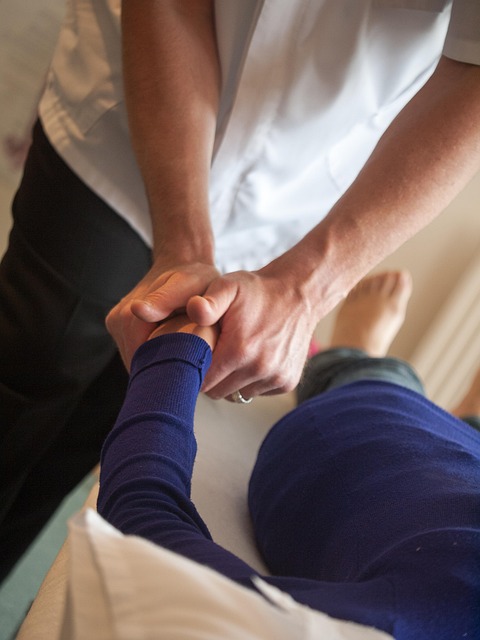Photobiomodulation, a non-invasive red light therapy, promotes muscle recovery by initiating biochemical reactions through specific light wavelengths absorbed by chromophores. Effective for accelerating healing, reducing inflammation, and boosting mitochondrial function, it offers a personalized approach tailored to individual physiological responses. This emerging technique shows promise in sports science for enhancing performance, speeding post-exercise recovery, and preventing overtraining injuries.
Red light therapy, a non-invasive treatment modality, is transforming rehabilitation and performance enhancement. Driven by the principles of photobiomodulation, this innovative approach accelerates muscle recovery, reduces inflammation, and promotes tissue regeneration. This article delves into the future advancements of red light therapy in these fields. We explore emerging techniques designed to optimize its effectiveness, discuss personalization and safety considerations, and investigate its growing role in athletic performance enhancement.
Understanding Photobiomodulation: Unlocking Muscle Recovery Potential
Photobiomodulation, a non-invasive therapy that uses specific wavelengths of light to interact with biological tissues, has emerged as a promising tool in sports medicine and rehabilitation. When applied to muscle recovery, this technology, often referred to as red light therapy, leverages the body’s natural response to light to stimulate cellular repair and regeneration. The process involves penetrating the skin with light, which is absorbed by chromophores within cells, leading to various biochemical reactions that enhance cellular function.
This approach has shown significant potential in accelerating muscle recovery after intense exercise or injury. By increasing circulation and promoting the synthesis of collagen and elastin, photobiomodulation can help reduce inflammation, ease muscle soreness, and speed up the healing process. Moreover, it may improve mitochondrial function, enhancing energy production at the cellular level and thereby supporting optimal muscular performance during training and competition.
Emerging Techniques for Enhanced Red Light Therapy in Rehabilitation
Emerging techniques are enhancing red light therapy’s potential in rehabilitation, particularly for muscle recovery. Beyond traditional low-level laser therapy (LLLT), advancements like photobiomodulation employ specific wavelengths and power densities to target cellular pathways involved in inflammation, apoptosis, and collagen synthesis. These innovative approaches aim to optimize tissue repair and promote faster recovery without side effects associated with some conventional treatments.
For athletes and active individuals seeking performance enhancement, photobiomodulation for muscle recovery offers a promising non-invasive alternative. By modulating mitochondrial function and reducing metabolic stress, red light therapy can improve muscle endurance, reduce post-exercise soreness, and accelerate recovery between training sessions. As research continues to uncover the full scope of red light therapy’s capabilities, its role in both rehabilitation and athletic performance is poised to grow significantly.
Optimizing Treatment Protocols: Personalization and Safety Considerations
Optimizing treatment protocols in red light therapy involves a deep dive into personalization and safety considerations. Each individual’s physiological response to photobiomodulation for muscle recovery varies, making it essential to tailor treatment plans. Factors like skin depth, tissue oxygenation, and individual healing rates influence the absorption of light and subsequent cellular responses. Healthcare professionals must consider these variations to ensure optimal outcomes while minimizing potential risks.
Safety remains paramount in any rehabilitation approach. Red light therapy, though generally safe when used correctly, requires precise dosing and monitoring. This includes adjusting treatment parameters like power density, exposure duration, and treatment frequency based on patient characteristics and specific conditions. By adhering to these personalized protocols, healthcare providers can maximize the benefits of photobiomodulation for muscle recovery while safeguarding patients from any adverse effects.
Performance Enhancement: The Role of Red Light Therapy in Athletics
Red light therapy, also known as photobiomodulation, has gained significant attention in the athletic world as a tool for performance enhancement and recovery. This non-invasive treatment utilizes specific wavelengths of red light to stimulate cellular functions, promoting muscle growth, repair, and overall athletic performance. By increasing circulation and reducing inflammation, red light therapy can accelerate the recovery process after intense training sessions or competitions, enabling athletes to return to their peak condition faster.
The benefits of photobiomodulation for muscle recovery are well documented. It helps in alleviating muscle soreness, improving flexibility, and enhancing collagen synthesis, which is crucial for tissue regeneration. With its ability to penetrate deep into the skin and muscles, red light therapy can reach areas that traditional rehabilitation methods might miss. This makes it a valuable addition to athletes’ training regimens, helping them maintain peak physical condition and potentially reducing the risk of injury associated with overtraining.
Red light therapy, through its potential for accelerating photobiomodulation for muscle recovery, holds significant promise not only for rehabilitation but also as a performance enhancer. As research continues to evolve, we can expect more refined treatment protocols that cater to individual needs while prioritizing safety. By embracing these advancements, both athletes and rehabilitators can harness the power of red light therapy to achieve faster, more effective results, marking a new era in sports science and physical therapy.
